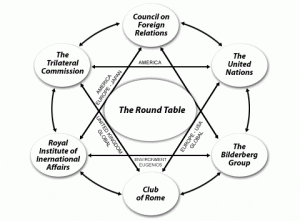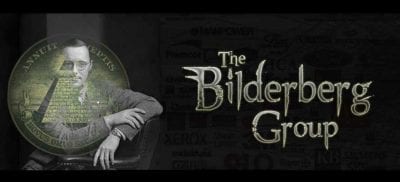Over half a century, the above steps cost EU members their sovereignty “as some 70 to 80 per cent of the laws passed in Europe involve just rubber stamping of regulations already written by nameless bureaucrats in ‘working groups’ in Brussels or Luxembourg.”
The EU and NAU share common features:
- advocacy from a influential spokesperson;
- an economic and later political union;
- hard line security, and for Europe, ending wars on the continent between EU member states;
- establishment of a collective consciousness in place of nationalism;
- the blurring of borders and creation of a “supra-government,” a superstate;
- secretive arrangements to mask real objectives; and
- the creation of a common currency and eventual global one.
Steps Toward a North American Union
- the October 4, 1988 Free Trade Agreement (FTA) between the US and Canada, finalized the previous year;
- at the 1991 Bilderberg meeting, David Rockefeller got governor Bill Clinton’s support for NAFTA if he became president;
- on January 1, 1994, with no debate under “fast-track” rules, Congress approved WTO legislation;
- in December 1994 at the first Summit of the Americas, 34 Hemispheric leaders committed their nations to a Free Trade of the Americas agreement (FTAA) by 2005 – so far unachieved;
- on July 4, 2000, Mexican president Vincente Fox called for a North American common market in 20 years;
- on February 2001, the White House published a joint statement from George Bush and Vincente Fox called the “Guanajuato Proposal;” it was for a US-Canada-Mexico prosperity partnership (aka North American Union);
- in September 2001, Bush and Fox agreed to a “Partnership for Prosperity Initiative;”
- the September 11, 2001 attack gave cover to including “security” as part of a future partnership;
- on October 7, 2001, a CFA meeting highlighted “The Future of North American Integration in the Wake of Terrorist Attacks; for the first time, “security” became part of a future “partnership for prosperity;” also, Canada was to be included in a “North American” agreement;
- in 2002, the North American Forum on Integration (NAFI) was established in Montreal “to address the issues raised by North American integration as well as identify new ideas and strategies to reinforce the North American region;”
- in January 2003, the Canadian Council of Chief Executives (CCCE – composed of 150 top CEOs) launched the “North American Security and Prosperity Initiative” calling for continental integration;
- in April 2004, Canadian prime minister Paul Martin announced the nation’s first ever national security policy called Securing an Open Society;
- on October 15, 2004, CFR established an Independent Task Force on the Future of North America – for a future continental union;
- in March 2005, a CFR report titled Creating a North American Community called for continental integration by 2010 “to enhance, prosperity, and opportunity for all North Americans;” and
- on March 23, 2005 in Waco, Texas, America, Canada and Mexico leaders launched the Security and Prosperity Partnership (SPP) – aka North American Union (NAU).
Secretive negotiations continue. Legislative debate is excluded, and public inclusion and debate are off the table. In May 2005, the CFR Independent Task Force on the Future of North America published a follow-up report titled Building a North American Community – proposing a borderless three-nation union by 2010.
In June and July 2005, the Dominican Republic – Central America Free Trade Agreement (DR-CAFTA) passed the Senate and House establishing corporate-approved trade rules to further impoverish the region and move a step closer to continental integration.
In March 2006, the North American Competitiveness Council (NACC) was created at the second SPP summit in Cancun, Mexico. Composed of 30 top North American CEOs, it serves as an official trilateral SPP working group.
Secret business and government meetings continue so there’s no way to confirm SPP’s current status or if Barack Obama is seamlessly continuing George Bush’s agenda. In an earlier article, this writer said:
SPP efforts paused during the Bush to Obama transition, but “deep integration” plans remain. Canada’s Fraser Institute proposed renaming the initiative the North American Standards and Regulatory Area (NASRA) to disguise its real purpose. It said the “SPP brand” is tarnished so re-branding is essential – to fool the public until it’s too late to matter.
Bilderbergers, Trilaterists, and CFR leaders back it as another step toward global integration and won’t “stop until the entire world is unified under the auspices and the political umbrella of a One World Company, a nightmarish borderless world run by the world’s most powerful clique” – comprised of key elitist members of these dominant organizations.
In April 2007, the Transatlantic Economic Council was established between America and the EU to:
- create an “official international governmental body – by executive fiat;
- harmonize economic and regulatory objectives;
- move toward a Transatlantic Common Market; and
- a step closer to One World Government run by the world’s most powerful corporate interests.
Insights into the 2009 Bilderberg Group Meeting
From May 14 – 17, Bilderbergers held their annual meeting in Vouliagmeni, Greece, and according to Daniel Estulin have dire plans for global economies.
According to his pre-meeting sources, they’re divided on two alternatives:
“Either a prolonged, agonizing depression that dooms the world to decades of stagnation, decline and poverty (or) an intense but shorter depression that paves the way for a new sustainable world order, with less sovereignty but more efficiency.”
Other agenda items included:
- “the future of the US dollar and US economy;”
- continued deception about green shoots signaling an end to recession and improving economy later in the year;
- suppressing the fact that bank stress tests were a sham and were designed for deception, not an accurate assessment of major banks’ health;
- projecting headlined US unemployment to hit 14% by year end – way above current forecasts and meaning the true number will be double, at minimum, with all uncounted categories included; and
- a final push to get the Lisbon Treaty passed for pan-European (EU) adoption of neoliberal rules, including greater privatizations, fewer worker rights and social benefits, open border trade favoring developed over emerging states, and greater militarization to suppress civil liberties and human rights.
After the meeting, Estulin got a 73-page report on what was discussed. He noted that “One of Bilderberg’s primary concerns….is the danger that their zeal to reshape the world by engineering chaos (toward) their long term agenda could cause the situation to spiral out of control and eventually lead to a scenario where Bilderberg and the global elite in general are overwhelmed by events and end up losing their control over the planet.”
Estulin also noted some considerable disagreement between “hardliners” wanting a “dramatic decline and a severe, short-term depression (versus others) who think that things have gone too far” so that “the fallout from the global economic cataclysm” can’t be known, may be greater than anticipated, and may harm Bilderberger interests. Also, “some European bankers (expressed great alarm over their own fate and called the current) high wire act ‘unsustainable.’ ”
There was a combination of agreement and fear that the situation remains dire and the worst of the crisis lies ahead, mainly because of America’s extreme debt level that must be resolved to produce a healthy, sustainable recovery.
Topics also included:
- establishing a Global Treasury Department and Global Central Bank, possibly partnered with or as part of the IMF;
- a global currency;
- destruction of the dollar through what longtime market analyst Bob Chapman calls “a stealth default on (US) debt by continuing to issue massive amounts of money and credit and in the process devaluing the dollar,” a process he calls “fraud;”
- a global legal system;
- exploiting the Swine Flu scare to create a WHO global department of health; and
- the overall goal of a global government and the end of national sovereignty.
In the past, Estulin’s sources proved accurate. Earlier, he predicted the housing crash and 2007 – 2008 financial market decline, preceded by the kind of financial crisis triggered by the Lehman Brothers collapse. Watch for further updates from him as new information leaks out on what the world’s power elites have planned going forward.
Stephen Lendman is a Research Associate of the Centre of Research for Globalization. He lives in Chicago and can be reached at lendmanstephen@sbcglobal.net. Original artical from GlobalResearch.ca
Chronological History of Events Related to the Bilderberg Group

First Bilderberg Meeting of the Elites Takes Place at the Bilderberg Hotel in Oosterbeek, Holland




